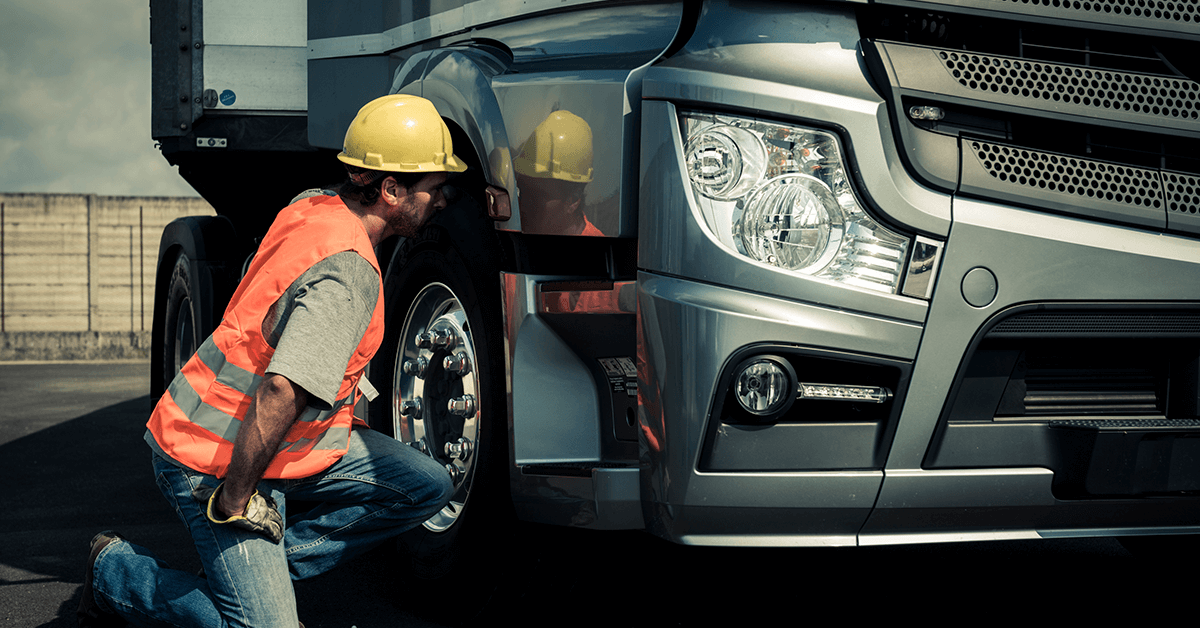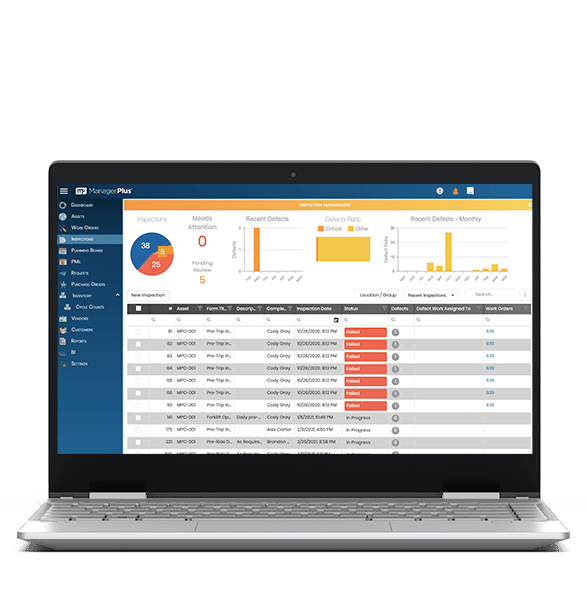For fleet operators, keeping drivers safe and vehicles on the road is a top priority, and pre-trip inspections help you do it.
The U.S. government provides detailed requirements for large commercial vehicles, but there are many things that smaller fleets can implement to help keep their fleet running smoothly.
Let’s look at how pre-trip inspections can protect your drivers, and help you get more from your vehicles.
What is a pre-trip inspection?
A pre-trip inspection is a thorough check of your vehicles before they hit the road to ensure everything is working properly. These inspections are designed to detect any potential malfunctions or failure points on the vehicle to both keep your drivers safe and prevent expensive repairs.
These inspections can be performed by your mechanics before the drivers head out for the day, and by the drivers themselves before they get behind the wheel. They should be performed every day that your vehicles are on the road and logged into a central database where they can be accessed and reviewed regularly.
What is the benefit of a pre-trip inspection?
Pre-trip inspections, while they do take time, are worth performing for a number of reasons:
- It’s often required by law.
- The safety of your drivers and others on the road is at stake.
- If you fail an audit or inspection while on the road, your organization could be fined.
There are practical benefits to performing pre-trip inspections as well. Regular inspections can alert you to potential problems with your vehicles. For instance, if one of your mechanics notices an unusual amount of pooling underneath a vehicle in the morning, he could further investigate and discover a leak in the radiator. Had he not performed a pre-trip inspection that day, that could have been a lot worse.
What should my mechanics look for in the pre-trip inspections?
The United States Department of Transportation (DOT) requires a 100+ point pre-trip inspection for commercial tractor-trailers, but smaller fleet vehicles don’t require as stringent of inspections.
Still, there are several things that are worth inspecting regularly. Let’s look at the three main categories.
Outside the vehicle
The first thing to check is the outside of the vehicle. Depending on the type of vehicles you have, each one has different things to inspect, but some of the main ones are:
- Engine
- Brakes
- Tires
- Mirrors
- Lights and reflectors
- Wipers
- Trailer couplings (if applicable)
- Load tie-downs (if applicable)
Each of these categories can be inspected quickly as you are mainly checking if the parts are functioning. Most of them are pass/fail components, meaning they are either working or they aren’t. Inspect the brakes to make sure they are functioning properly.
Comprehensive engine inspections should be performed regularly, but for the daily pre-trip, a simple visual inspection should suffice. Check for any major breaks or leaks and make sure all fluid levels are adequate.
For the tires, you can use the simple coin test to see if the treads are low and visually examine the tires for any signs of leaks or punctures.
For the mirrors, simply making sure they are intact and adjustable is all you need. Same for the lights and reflectors. As long as the lights aren’t broken and turn on and off, you’re good to go.
While the wipers also need to be checked for simply on/off functionality, every vehicle also has wiper fluid that should be checked regularly to ensure it’s filled properly. You may not need to check the wiper fluid level every day, but it should be checked regularly, at least once a month.
If your drivers are hauling any trailers, you need to make sure that the trailer couplings are thoroughly inspected before every trip. Look for rusted pins and chains, broken wires, low tires, etc., to make sure nothing happens to the trailer while it’s being towed.
The same applies if you have vehicles with heavy loads such as pickup trucks or vans. Make sure to double-check that the loads are properly secured to avoid any potential safety hazards.

Inside the vehicle
When inspecting the inside of the vehicle, be sure to check:
- Seatbelts
- Driver’s seat
- General cab cleanliness
- Heater/air conditioning
- Windows
- Horn
- Safety equipment (if applicable)
Most of these categories are pretty self-explanatory, but it’s important to check them all. A broken driver seat may cause the driver to lose control of the vehicle while on the road, and if bottles and trash on the floor of the cabin might get caught under the petals, making it impossible for the driver to apply the brakes.
Ensuring proper heating and cooling for the driver helps keep them safe. If they are not able to stay comfortable while driving, it’s much harder to pay attention, and the risk of an accident increases. Properly functioning windows are vital in the case of an emergency. If there is an accident and the door will not open, the driver needs to be able to exit through the window.
Vehicle controls
The last main category you need to inspect is the vehicle controls. Here, look at things like:
- Brakes, including the parking brake
- Driver controls and gauges (speedometer, etc.)
- Headlights and turn signals
- Steering wheel
These are all pretty standard things that are required to operate the vehicle safely. Simply check to make sure each item is functioning properly.
How can I keep track of my inspection reports?
Inspections are critical for discovering issues at the moment, but they can actually give you even more value long-term. In most cases, government regulations require companies to keep inspection records readily available, and analyzing your inspections over time can help you maintain your vehicles more efficiently, which keeps costs down and extends their life cycle.
To realize the full value of your inspection reports, you need to store them efficiently. Many organizations still use paper or spreadsheets to track their inspection reports which are inefficient and can lead to inaccurate information.
The best way to keep track of your inspections is with inspection management software. With all your inspection reports stored in a centralized, cloud-based database, you can instantly access them when it’s time for an audit. You can also go back and view your work orders over time to spot any issues or hidden costs like certain vehicles that are needing more repairs than others.
This software helps your team perform inspections more efficiently as well. With mobile applications and QR codes, your technicians can scan the vehicle and instantly access the information related to that vehicle, perform the inspection, and sign off on it all from their Internet-connected device.
How can I repair our fleet vehicles more efficiently?
Inspection management software can help you do more than just manage and track your inspections. As part of a larger fleet management solution, it also helps you maintain your vehicles more efficiently.
Develop
Develop a robust preventive maintenance program for your vehicles that helps you anticipate maintenance problems and fix them before they become larger issues.
When maintenance work is needed, instead of writing out a work order by hand or trying to track maintenance jobs in a spreadsheet, manage your work orders right from within the software solution. Automatically generate and assign work orders for routine tasks like replacing the oil or changing the spark plugs, so important maintenance always gets done on time.
Build
Build custom work order templates with pre-trip inspection checklists so you know your mechanics are inspecting the right things every time. And help keep everyone accountable by requiring a signature to close out the inspection work orders every morning.
All of your data, including inspection reports, work orders, even parts and inventory information, and more, is stored in one, always connected database so you can access your data any time you need it. This means you can analyze the data and generate detailed reports on the metrics and KPIs that you need to track.
Track
Track your costs across your entire fleet and find new ways to save money and track your vehicle’s total cost of ownership so you always know the best time to replace your vehicles.

Summary
Pre-trip inspections are important before your drivers ever get behind the wheel. Not only do they keep your drivers safe, but they also help keep your vehicles well maintained and extend their life cycle. For Commercial Motor Vehicles (CMV), the Department of Transportation (DOT) requires a 100+ point inspection before every trip. Smaller fleet vehicles do not require as much inspection, but there are still regulations in place that must be followed to avoid fines and litigation. Use inspection management software as part of a fleet management solution to efficiently keep track of your inspection reports and streamline your maintenance operations to cut costs and improve your ROI.

Next steps
Are you ready to streamline your inspections and improve your maintenance operations? The first step is to implement fleet management software, and the best way to do that is by talking with the people who know the challenges your company is facing, and how our ManagerPlus solution can help you meet them. Schedule a personalized, one-on-one conversation with an expert to learn more about how fleet management software can help you meet your goals.

